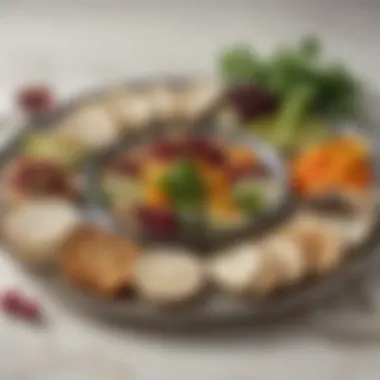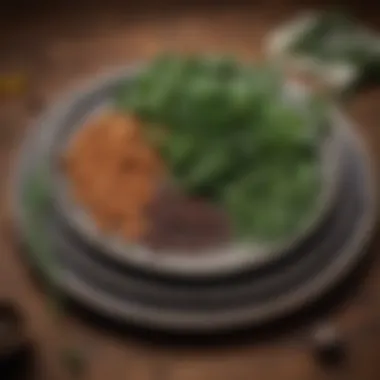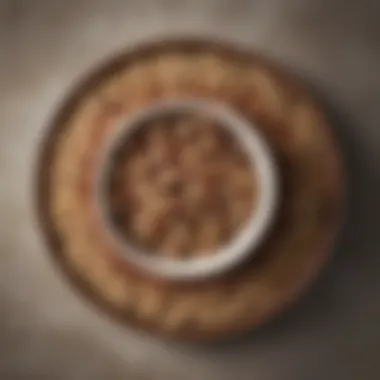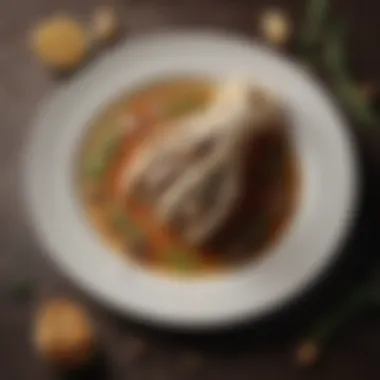Exploring the Elements of the Pesach Seder Plate


Intro
The Pesach plate, also known as the Seder plate, is more than just a platter laden with symbolic foods; it is a vivid tableau of history, memory, and faith. Each component on this plate serves as a reminder of the passage from slavery to freedom, encapsulating the essence of the Passover holiday. When families gather around the table during the Seder night, the Pesach plate takes center stage, guiding the ritual and invoking stories of resilience and heritage.
As we explore the crucial elements of the Pesach plate, this article will shed light on the importance of each ingredient, how they are prepared, and the stories they tell. Not only will this offer insights into traditional practices, but it also aims to deepen connections to the rich cultural tapestry that defines Jewish history.
In examining this cherished tradition, we dive into the heart of Passover, where the ingredients on the plate come to life with meaning and significance, celebrating the triumph of the spirit over adversity.
Prelims to the Pesach Plate
The Pesach plate, a central feature in the Passover Seder, is not just a collection of ingredients, but a tapestry woven from history, tradition, and deep cultural meaning. Each component serves a crucial role, embodying lessons and themes that echo throughout generations. Understanding the Pesach plate means engaging with these layers of significance, from the stories the ingredients tell to the rituals that surround them.
This exploration into the Pesach plate invites readers to appreciate the multifaceted insights that these symbolic foods provide, enriching both the Seder experience and our connection to Jewish heritage.
Historical Context
The origins of the Pesach plate are steeped in antiquity. Traditionally, it recalls the Israelites' exodus from Egypt, a defining story in Jewish history. The blessings and burdens they faced in bondage resonate through the symbols on the plate. Each item links back to the narrative of liberation and faith.
The earliest mentions of similar practices date back to the Biblical era, where the tradition of sacrifices and commemorative meals were common. Over centuries, various communities embraced distinct customs, further enriching this historical backdrop. Notably, the importance of storytelling during the Seder is not just about recounting history; it serves as a reminder to future generations about the significance of remembrance.
Purpose in Passover
The Pesach plate fulfills several purposes during Passover, all intertwined with ritual and reflection.
- Symbolism: Each item on the plate symbolizes a distinct facet of the Passover story, from the bitterness of slavery to the hope of freedom.
- Education: Through the act of engaging with the plate’s ingredients, participants tell the story of Exodus to family and friends, integrating lessons from the past into the present.
- Connection: The shared experience built around the Seder plate strengthens community bonds. It evokes a sense of belonging, as individuals gather to participate in these cherished traditions.
"The Seder plate acts as a bridge between past struggles and present celebrations, allowing each generation to partake in a living history."
Additionally, the act of preparing the Pesach plate is often a communal one. Family members collaborate to ensure that each ingredient is kosher and meaningful, making its preparation an act of unity and reverence. This communal effort elevates the experience, reinforcing the idea that collective memory and identity are crucial to the Passover celebration.
In summary, the Pesach plate is a rich emblem of tradition and story. It beckons to be understood, appreciated, and celebrated, forming an integral part of the annual observance that resonates with both joy and solemnity.
Components of the Pesach Plate
The Pesach plate serves as the cornerstone of the Passover Seder, embodying the rich tapestry of Jewish tradition, and, each component, laden with history and significance. Understanding these components not only sheds light on their individual roles but also emphasizes their collective function in the Seder—a true feast for both body and spirit. Engaging with the ingredients means diving deep into their cultural flavors, spiritual meanings, and historical contexts. Each item sparks dialogues, memories, and reflections, making the Seder a living memory rather than a mere ritual.
Maror – Bitter Herbs
Types of Maror
Maror, commonly understood as bitter herbs, is pivotal in symbolizing the bitterness of slavery experienced by the Jews. The most popular type of Maror is horseradish, renowned for its intense pungency and eye-watering properties. Ground fresh or jarred, horseradish brings a fierceness to the plate that cannot be ignored. Another traditional choice is romaine lettuce, not as intense but still bitter in flavor, offering a milder experience that more delicate palates might appreciate.
Unique Feature: The sharpness of horseradish triggers a physical response—tears—creating a visceral connection to the pain of oppression.
Symbolism of Bitterness
Bitterness here serves as a reminder of the Jewish experience of suffering and hardship during slavery in Egypt. This symbolism communicates strength over adversity—a powerful narrative within the Jewish identity. Maror’s sharp flavor invites participants to not just consume but reflect on historical struggles, making it a fundamental aspect of the Seder.
Key Characteristic: Its ability to awaken memories and emotions reinforces its place on the plate. The symbolism is both instructive and personal, offering layers of meaning that can be shared across generations.
Charoset – Sweet Mixture
Ingredients Used


Charoset contrasts the bitterness of Maror, often made from apples, nuts, wine, and spices. This sweet mixture represents the mortar used by Jewish slaves for building in Egypt. The texture is thick, almost a paste, embodying hardship yet transforming it into something delightful. The ingredients speak volumes about Jewish culinary tradition, often changing from community to community—some might add figs or even dates.
Key Characteristic: Each family’s recipe can greatly vary, encouraging a personal touch to this symbolic dish.
Cultural Variations
These variations are fascinating; in Sephardic tradition, charoset often includes more exotic spices and fruits like pomegranates or apricots. In contrast, Ashkenazi communities may prefer a more straightforward apple-walnut base. This diversity not only enriches the Seder experience but also connects participants to their roots, ensuring that traditions stay vibrant and alive.
Unique Feature: Charoset’s adaptability showcases how food transcends simple nourishment and becomes a historical narrative.
Karpas – Vegetables
Common Vegetables
Karpas is typically represented by a vegetable such as parsley or celery, blanched or fresh, served alongside salt water to symbolize the tears shed during slavery. Like a fresh breath of spring, the green color signifies rebirth and renewal, an essential theme in Passover.
Key Characteristic: Its role as a starter—it awakens the palate and leads into deeper discussions about the Seder’s meanings. The salt water, which is dipped during the ceremony, adds another layer; it connects with the tears shed during long years of exile.
Significance in Tradition
Karpas has a dual role; it is both a ceremonial practice and an interactive one. When dipping the vegetable into salt water, participants engage in a physical act that embodies a larger narrative about suffering and transcendence. The actions taken during the Seder serve to link hands and hearts, enhancing the fabric of family and community.
Unique Feature: This vegetable connects past with present, reminding all involved that the journey of the Jewish people is ongoing.
Z'roa – Roasted Bone
Types of Bones Used
Z'roa typically includes a roasted lamb shank bone, symbolizing the Paschal lamb sacrificed during the Exodus. The use of such a bone is more than a culinary decision; it is a historical representation echoing the sacrifices made for freedom. Some families opt for a chicken bone if lamb isn’t available, though lamb carries the stronger historical weight.
Key Characteristic: It instinctively informs participants about the sacrifice central to their narrative.
Symbolic Meaning
The roasted bone embodies the concept of redemption, connecting participants with the overarching theme of liberation. As the bone graces the plate, it openly speaks of strength and sacrifice, prompting discussions about what it takes to seek freedom.
Unique Feature: Within this seemingly simple ingredient lies the profound understanding of sacrifice; it enriches the shared experience during the Seder Moments.
Beitzah – Roasted Egg
Preparation Methods
The Beitzah, or roasted egg, is prepared with care, often grilled or roasted until it develops a beautiful char. The egg represents the festival offering from the Temple and is a signifier of mourning for the lost Temple, yet also symbolizes new beginnings and regeneration with its round shape.
Key Characteristic: Its method of preparation can vary, but the goal is to achieve a lovely crisped finish to highlight its essential role on the plate.
Interpretations of the Egg
The egg, like many elements of the Pesach plate, carries rich layers of meaning. It’s often viewed as a symbol of life and renewal—an archetype of hope. In some interpretations, its presence serves a dual purpose, reminding that while the past holds sorrow, there is always room for rejuvenation.
Unique Feature: The versatility of the interpretation of the egg allows for personal connection, emphasizing how each person at the table can resonate with its symbolism.
In summary, the components of the Pesach plate do much more than offer a meal; they provide a portal into history, culture, and collective memory. Every ingredient contributes to a rich experience that allows families and communities to forge connections, honoring the past while moving towards hopeful futures.
Preparation of Pesach Plate Ingredients


Preparing the Pesach plate is an integral part of the Passover celebration, laying the groundwork for a meaningful Seder experience. Each step taken in the preparation is steeped in significance, connecting the act of cooking and arranging with the rich tapestry of Jewish history and tradition. Food, in this context, holds more than mere sustenance; it symbolizes freedom, heritage, and the struggle for identity. During this period, whether it’s the method of selection or the techniques used, every consideration contributes toward honoring age-old customs.
Selecting Fresh Ingredients
When it comes to the Pesach plate, the freshness of the ingredients may not be underestimated. Fresh veggies, herbs, and proteins embody the vibrancy of life and renewal, which coincides with the themes of Passover. Choosing items that have been recently harvested or prepared resonates with the core value of Kashrut – maintaining a diet that is pure and wholesome. When selecting fresh ingredients, one must consider not just the appearance but also the story behind each offering.
- Challenging choices: While heady aromas of fresh herbs like parsley or romaine lettuce can lure you in, making sure these are grown in compliance with B’Tzelem Elohim, respecting the intent behind their origin, enriches the overall experience.
- Quality over quantity: A few select items that shine with freshness always trumps a lavish yet stale arrangement.
Methods of Preparation
The methods of preparing the ingredients for the Pesach plate play an equally vital role in ensuring that the customs are duly honored and that the plate’s elements are professionally handled.
Cleaning Procedures
A detailed cleaning procedure sets the stage for purity in the ingredients. Thoroughness stands as a key characteristic of this step, often embraced by those wanting to ensure that any lingering hametz (leaven) is eliminated.
- Washing: Begin with rinsing each vegetable under cold water. This simple act is pivotal; it removes dirt along with any beliefs of impurities. For instance, soaking herbs in a vinegar solution not only cleans but enhances the overall freshness.
- Unique feature: Besides basic washing, many traditions incorporate salt or baking soda for an extra level of cleansing. This practice is thought to elevate the kashrut, especially relevant for the intended purpose during Passover.
However, one must tread lightly; over-saturation could leave some items woefully soggy, which isn’t particularly appetizing.
Cooking Techniques
For the components of the Pesach plate, cooking techniques can vary tremendously, providing a mosaic of flavors and textures. The goal here is not just to prepare but to retain the distinctiveness of each element.
- Roasting: For instance, the Z'roa, or roasted bone, should ideally be cooked until crisp; this gives it a delightful texture and aromatic presence. This method enhances the bone's character while maintaining its symbolic representation.
- Unique feature: The technique of steaming vegetables, often used for Karpas, keeps nutrients intact while enhancing natural flavors. This gentle approach preserves the vibrancy, making the dish more enticing.
While various methods of cooking can elevate a dish, one must remember that simplicity is also key during Passover preparations. Overdoing it might clutter the plate, losing the focus on the story behind each ingredient.
Significance of the Pesach Plate Ingredients
The Pesach plate, or Seder plate, acts as a visual tableau of the Jewish Passover celebration, with each ingredient steeped in layers of meaning. It’s not merely a ceremonial arrangement but a profound reflection of history, tradition, and cultural identity. Understanding the significance of each component on the plate facilitates a deeper connection to the rituals of Passover, as well as the broader Jewish experience.
Cultural Interpretation
In various communities, the ingredients of the Pesach plate symbolize resilience and unity. For instance, the Maror, or bitter herbs, serves as a stark reminder of the hardships faced during slavery in Egypt. It evokes a visceral reaction, allowing participants to taste the bitterness of oppression, thereby reinforcing the value of freedom and liberation. The Charoset, typically a sweet mixture of nuts, apples, and wine, contrasts sharply with the Maror. Its sweetness represents the hope and promise that emerge from suffering, linking the past to the present through culinary interpretation.
Across different cultural contexts, variations in these ingredients can provide a glimpse into how local customs shape the ritual. For example, while Ashkenazi Jews often use horseradish as Maror, Sephardic traditions may incorporate different bitter greens such as romaine lettuce. This divergence highlights how cultural environments shape religious practices, while still maintaining an essence of shared heritage.
"The Seder plate ingredients not only reflect Jewish history but also enrich the connection to cultural identity and solidarity within the Jewish community."
Religious Importance
Religiously, the Pesach plate serves crucial functions during the Seder. Each component has a specific role within the service. For example, the Z'roa, a roasted shank bone, symbolizes the Paschal lamb, called to mind the sacrificial practices of ancient times. It fosters reflection on the themes of atonement and redemption central to Passover. Moreover, the Beitzah, or roasted egg, acts as a symbol of mourning and renewal, representing both the cycle of life and the destruction of the Temple in Jerusalem.
The entire ritual serves as a communal experience where retelling the Exodus story is paramount. Families gather around the Seder plate to engage in dialogue about personal and collective narratives derived from these items, which transcend mere symbolism and touch on faith and spiritual continuity. The tactile experience of the ingredients—each with its journey and significance—provides a tangible connection to generations past. In essence, the significance of the Pesach plate ingredients sits at the crossroads of remembrance, hope, and communal identity, enhancing the observance of Passover across generations.
Common Variations in Different Communities
The Pesach plate features a rich tapestry of ingredients, each encapsulating age-old customs and meanings. These variations across communities not only reflect cultural nuances but also highlight how traditions adapt while preserving their core essence. In essence, these differences enrich the Passover experience, allowing families to explore their heritage and draw connections with their roots.
Ashkenazi Tradition
Among the Ashkenazi Jews, one of the most notable distinctions on the Pesach plate is the use of Maror, typically represented by horseradish. This choice carries a bitter memory of slavery in Egypt, emphasizing the struggle endured. In this tradition, the Charoset is often made using apples, walnuts, cinnamon, and red wine, creating a sweet contrast to the Maror's bitterness. The texture here is significant; a chunky charoset mirrors the mortar used by Jewish slaves in ancient Egypt, reinforcing poignant memories.
Another unique element includes the Karpas, usually parsley, which is dipped into salt water to symbolize tears shed during enslavement. This act not only marks the beginning of the Seder but also sets a reflective tone for the evening, engaging each participant in the story of their ancestors.


Family recipes often play a crucial role in these traditions, passed down through generations. For many, it’s not just about the taste, but the connection it forges with prior generations at the table, making the Passover meal more than just a culinary affair.
Sephardic Tradition
In stark contrast, the Sephardic tradition incorporates more diverse ingredients that reflect their rich Mediterranean backdrop. For instance, their Charoset might include figs, dates, or even pomegranate seeds. This not only highlights regional availability but also creates a culinary fusion that is distinctively vibrant and flavorful.
The Maror, often less pungent than horseradish, might be represented by romaine lettuce or endives. This choice maintains the essence of bitterness but introduces an element of freshness that resonates with the climate of their homelands.
Dishes like Karpas in Sephardic homes can vary greatly. While many still opt for parsley, others may choose potatoes or beets, bringing different colors and flavors that celebrate diversity in tradition. This adaptability underscores their approach to tradition - rooted in history but dynamically evolving.
In both traditions, the Beitzah and Z'roa retain their symbolic roles but might see slight variations in preparation based on local customs.
These community differences serve a dual purpose. They act as reminders of the historical journeys and migrations of Jewish people while simultaneously enriching family gatherings with a mélange of flavors and stories. Each bite not only nourishes the body but also engages the spirit, ensuring that the Pesach plate remains a living artifact of the Jewish experience across generations.
Interpreting the Seder Plate in Modern Times
The Seder plate, a quintessential aspect of the Passover celebration, is not just a static collection of symbolic items; it constantly evolves as customs shift and society changes. In contemporary times, the plate's interpretation reflects broader cultural influences and incorporates culinary innovations that speak to a diverse range of participants. This section illuminates how modern approaches to the Seder plate preserve the essence of tradition while embracing creativity.
Culinary Innovations
Culinary innovations play a significant role in how the Seder plate is perceived today. Traditional ingredients still hold their place, but chefs and home cooks alike are bending the rules and experimenting with new flavors and textures. For instance, some have swapped out classic horseradish for spicy wasabi to add an unexpected kick to the maror. Meanwhile, charoset, often made from apples and walnuts, is being reimagined with unconventional ingredients like tropical fruits or different nut types, catering to various palates.
Moreover, these adjustments are not only a reflection of personal tastes but also indicate a growing trend towards inclusivity. Diverse cultural backgrounds can be embraced, enhancing the plate’s significance in a contemporary setting.
- Some examples of innovative charoset recipes include:
- Mango and coconut varieties for a tropical twist.
- Pomegranate and pistachio for a colorful and flavorful take.
The push for plant-based and gluten-free options has expanded the possibilities even further. The Seder plate is now a way to showcase one's culinary creativity and personal story while still honoring the history behind each ingredient.
Seder Plate Redefinitions
As understanding and interpretation of Jewish traditions evolve, so too does the concept of the Seder plate. It stands as a dynamic representation of cultural and religious identity. For many today, having a Seder plate that resonates with their values and beliefs is crucial. This has led to a redefinition of what a Seder plate entails.
Some people have begun crafting personal Seder plates that reflect their unique backgrounds and beliefs. This can mean using locally-sourced ingredients or even creating symbolic elements that speak to modern societal issues. For example, a participant might include a small representation of an olive branch to symbolize peace, challenging the traditional interpretations.
By doing this, the Seder plate transforms into a canvas that can narrate personal stories and current concerns. As the meaning of Passover expands, individuals find connection in their personal tributes to tradition, allowing the observance to adapt without losing its core significance.
"The Seder plate in modern times is a bridge between age-old traditions and today's cultural narratives. It's a platform for dialogue, reflection, and innovation."
As we see these reinterpretations, the essence of Passover remains: remembering the past while moving forward. In the modern context, the Seder plate invites us not only to celebrate but to also engage in a deeper understanding of our identities and heritage.
The End
As we draw to a close, it is essential to consider the weight of the Pesach plate in the Jewish faith and its profound significance during Passover. The ingredients on this plate are not merely food items; they embody centuries of history, tradition, and communal identity. Each component brings with it a narrative that resonates deeply within the hearts and homes of those who observe the Seder.
Reflection on Traditions
Every item on the Pesach plate serves a symbolic role. For instance, Maror's bitterness offers a tangible connection to the suffering of our ancestors. It’s a vivid reminder of the hardships endured during slavery. When families gather and recount these stories, they foster a shared memory that can transcend generations. The act of engaging in these rituals forms a collective identity. During a Seder, as matzos are broken and blessings recited, participants are not engaging in merely a meal, but rather in the evocation of historical narratives.
This reflection on traditions not only revitalizes our relationship with the past but also cements the values we hold dear today. We find meaning in storytelling, passing down vital teachings from one generation to the next. The Seder plate becomes a vessel of memories, where the flavors of the past linger on our taste buds, connecting us to our ancestors and reinforcing our cultural heritage.
Continuing Practices
Continuing these practices in contemporary times requires adaptation to modern lifestyles while still honoring historical significance. Communities, whether Ashkenazi or Sephardic, present the Pesach plate in a way that encompasses their unique lineage but all share the common thread of remembrance.
In today’s world, one may discover culinary innovations that bring new life to traditional dishes. From spiced charoset recipes that include tropical fruits to artistic presentations of the Seder plate that incorporate local ingredient twists, the essence remains the same while embracing creativity. This ability to merge the old with the new is vital, ensuring that these practices remain relevant in the evolving landscape of society.
Additionally, many families are now documenting their Passover experiences online, sharing interpretations and personal stories. This reinforces the community spirit, drawing more people into the ritual each year. Social media platforms and community blogs function as modern-day Haggadahs, illustrating how deep-rooted customs can thrive through contemporary practices.
As we reflect upon the Pesach plate and its ingredients, it's clear that they are more than what meets the eye. They are joyous and profound reminders that bind us to our history, our family, and our faith, whispering tales of resilience and unity at every gathering.







